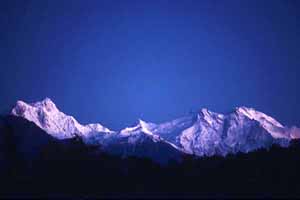|
|
 |
Nanga Parbat
|
|
 |
Known as the "Killer Mountain," Nanga Parbat (8125m) is the 9th highest peak in the world and perhaps the most challenging. Anchoring the western end of the Himalayan Range, Nanga Parbat was first climbed in 1953 by Herman Buhl. The following two treks take one to the north and south faces of this magnificent mountain.
This trek leads to the base camp of Nanga Parbat's southern face, the most dangerous and difficult of all the routes to the summit. From Gilgit, drive through the gorges of the Astor Valley to the beautiful alpine village of Tarashing. From here, it is a two day hike to the base camp, which is set amidst a lush alpine meadow. Enroute traverse the Chumphere and Bazin Glaciers, before reaching the traditional base camp, locally known as Latobah. From this area there are spectacular views of the towering 5000m Rupal Face of Nanga Parbat. The entire trek parallells Rupal stream, and offers fine views of Chongra (6447m) and Rajkot (7074m) peaks. After spending a day at leisure exploring the area, recommence the two day return trek to Tarashing, and then jeep to Gilgit.
Fairy Meadows, so named because of local superstition that fairies inhabit this spectacularly forested alpine meadow, is a wonderful setting from where to explore Nanga Parbat. One will drive from Gilgit to Jeyal, and from there walk a few hours to Fairy Meadows. Shepherd's huts are scattered around the area, and clear water is plentiful - coupled with the pine forests and the looming north face of Nanga Parbat, one can readily believe that fairies really do live in this alpine meadow. The next day's trek will lead to the base camp of this trek, Beyal, from where day excursions will be made to the German memorial to those killed in the 1937 expedition, and to the foot of Jiliper Peak. On the return, stop for the night at Fairy Meadows, before trekking to the road head and driving back to Gilgit.
![]()